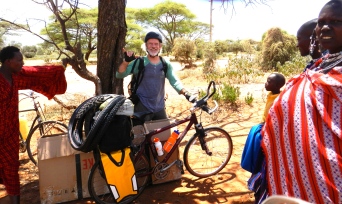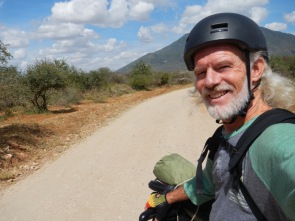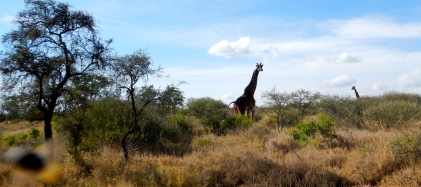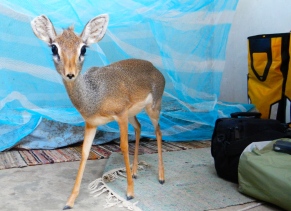Leaving Kitumbeine, I was making good time on my mountain bike, although the road had certainly become much rougher. My plan was to arrive in Gelai Bomba by midday to refill my water containers, as this was the only stop between Kitumbeine and Engaresero. The road, and I use that term loosely, winding around rocky knolls and plunging down ravines into dry riverbeds, was now consuming one hundred percent of my concentration. No time for observing the numerous zebra, Thompson gazelle, Maasai giraffe, dik dik and gerenuk. Negotiating one particularly steep ravine, my front tire struck a rock and I flipped over the bike.
This time was not a slow-mo experience nor a soft landing. I landed on my head, colliding with a rock near my left temple. Fortunately my helmet absorbed most of my fall.
Observe the dent!
No broken bones!
No broken bike!
OK…….I must be more careful!
Arriving in Gelai Bomba at 1300, I still felt good about my progress. I was just a bit less than half way there. I filled my water containers at the local duka (small general store) and sat down to enjoy a “cold” (I was promised) bottle of Stoney Tangawizi, but alas, it was of ambient temperature, although it was taken from the refrigerator.
While enjoying my “cold drink”, I noticed a couple of Maasai men standing around the duka. I will take the liberty to call them “drugstore Maasai”. The shorter one was wearing traditional Maasai attire: a red shuka, beaded ear décor, and holding the warrior spear with a seme (double bladed long knife) attached to his leather belt. The taller one wore an Emirates T-shirt and was without the customary ear piercings, but did have the traditional circular branding on his cheeks. He was eager to converse in both Swahili and English, stating he had finished Form 6 in school there. The other one remained silent. As I saddled up the bike, the one in the Emirates T-shirt repeatedly requested money, to which I smiled and said “No”.
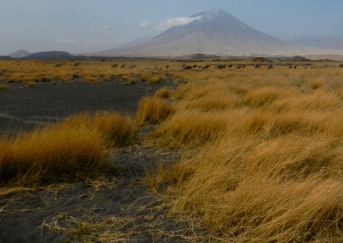
I glanced down at the trail I was to follow, crossing a ravine and then ten miles of dusty, sandy, desolate savannah, doted with only a few hardy Acacia trees. After crossing the ravine, the volcanic sand became too difficult to ride over. I dismounted and commenced my journey into the porini (wilderness). Only then did I notice two Maasai following behind me. Yes, one was in traditional attire, the other an Emirates T-shirt. They caught up with me shortly and requested that I hire them as a guide. I insisted that I would guide myself. Not giving up, they asked again for money. I ignored them.
We traveled in silence for several more miles. I began contemplating my situation. The entire day had passed without sighting a single car. I was now getting tired and thirsty and I had two Maasai escorts. Their persistent begging for money left me slightly uncomfortable of their intentions. Welcoming a large Acacia tree, I leaned my bike against the trunk. My visitors followed me, again requesting money. They stated that I owed them a “Gate fee”.
The “Gate fee” is an entirely different subject. The local districts around the Ngoro Ngoro and Serengeti National Parks have observed that tourists are paying many dollars to enter through the gates. Not surprising, little or no revenue benefits the local population. In their wisdom, the Maasai have set up not-so-legal roadside “gates” along tourist routes which pass through their districts. They collect fees which they insist benefit the local schools and development projects. I suspect most of it ends up in Mombasa or Dar Es Salam, however.
Well, I knew for a fact that there was no “gate fee” at Gelai Bomba, not even a gate. Impatient now, the shorter Maasai (the one in traditional attire) pulled out his seme and said “kali” as he placed my fingers on the double bladed long knife. With half attempted swings at my legs, arms, and throat with the seme, he then indicated that he wanted money. He was certainly a man of few words, but his point was well taken. Meanwhile the one in the Emirates T-shirt took the spear and held it back in a cocked position aiming at me, making throwing motions. I knew now that we had us a situation, a hostage situation. I calmly told them “nimechoka” (I am tired), and sat down on a stone. They in turn withdrew their weapons and sat down. Making small talk we sat under the shade of that tree. They demanded water now. I ignored their demands. I was dead here without water. They were Maasai and could travel all day without it. An hour passed under that tree; at times they would withdraw the big knife and flash it at me. Thoughts of using a nearby rock as a weapon or throwing dirt into their faces somehow did not seem as a logical means of escape. Glancing back at the trail, I noticed two Maasai women walking my way. Was this a mirage? My escape plan went into action as I stood up and took my bike pushing it toward them. “Takwenya” I called, (a Maasai greeting to women), as I approached them. My two “drugstore Maasai” followed for a few steps hurling insults at me and then turned back. “Sere”, I smiled. “Goodbye”.
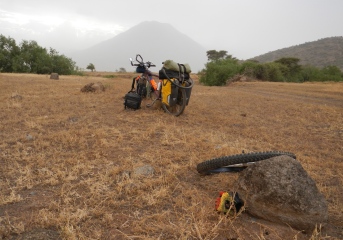
The two women, God’s Maasai angels, soon left the trail, and I was alone again. Except for a few rideable sections, I pushed and pulled the bike through the sand for the remaining ten miles, but not before I had another flat tire.
Not fair. I wasn’t even riding when it went flat.
Reaching the main road at sunset, I was exhausted, thirsty and hungry. I pulled out my foam mat, just to rest for a few moments along the side of the road. The Tillamook cheese, which I had saved from the KLM flight, was now a bit aged, but it was delicious.
I must have dozed off, but was awakened when I became aware of a familiar, but eerie night sound. “whoooo-OOOP”.
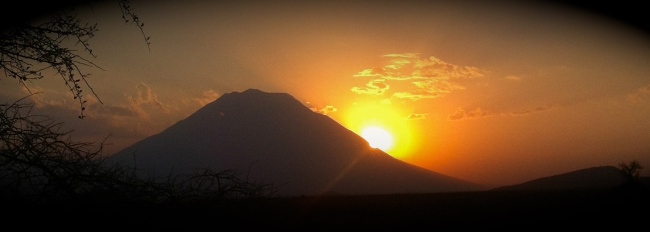
The full moon was now up and I could see the outline of a spotted hyena as it circled my location. I watched it for a few minutes in apprehension as it continued to circle. Was it the Tillamook cheese or me that fascinated it? My sense of humour had vanished. Shining my flashlight, I said, “toka”, (get out of here). He skulked over to a nearby tree and watched. Not tempting any further confrontations, I hopped on my bike and pedaled down the moonlit road. Even with the headlamp on, the rocky road was difficult to negotiate.
Knowing there was a “gate” a few miles down the road, I pedaled on into the night. Upon reaching the abandoned “gate”, as the toll man returns home in the evening, I decided to spend the night in the door-less “gate shack”. Unfolding my foam mat once again, I secured the door opening by locking the bike in front of it. Enjoying an uneventful remainder of the night, I awoke to a beautiful day and a pleasant ride to my destination, Engaresero.
Incidentally, my son, Scotty, has been working on this beautiful tented campsite at World View Campsite, Engaresero, Lake Natron.
KARIBU!

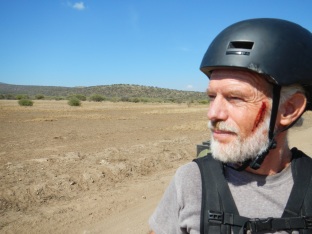
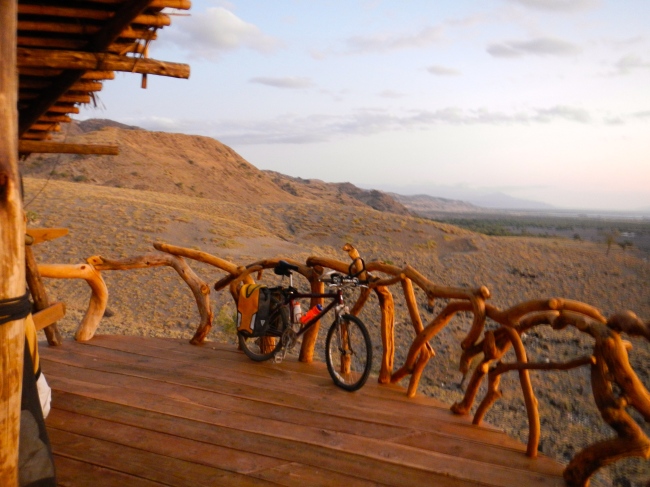
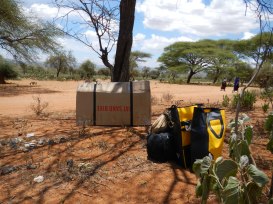 The bus pulled off the road at the turnoff to Kitumbeine, a few kilometers from the town of Longido. I took my luggage and the bike in a box and placed them under an A
The bus pulled off the road at the turnoff to Kitumbeine, a few kilometers from the town of Longido. I took my luggage and the bike in a box and placed them under an A